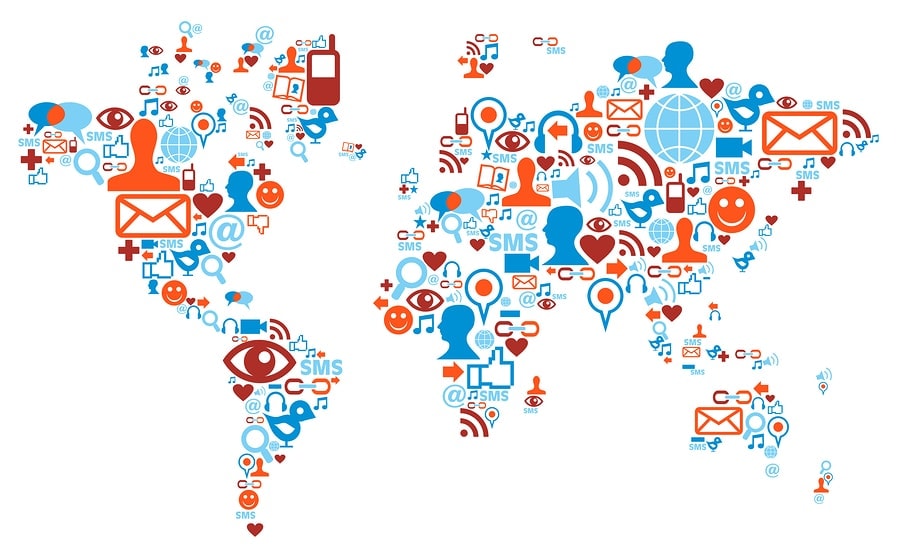Humans are a social animal. Communication comes to us instinctively. And we’ve been at it a long time, from cave paintings to hieroglyphics, to the telegraph, to television. But something about our communication changed at the dawn of the 21st century. Technology gave people, really for the first time, a way to share a message with a wide, potentially global, indeterminate and unknown audience, and hear back from them. And what’s more, you didn’t need to be a chief, a scribe, or Edward R. Murrow to get your ideas out there — social media was open to everyone.
So how did this type of communication come about? And what has it meant for business? Here’s a brief history of what we know today as social media came to be.
“Just setting up my twttr.”
@Jack, Twitter founder Jack Dorsey that is, sent that message as the first tweet on March 21, 2006. Dorsey, Ev Williams, and Biz Stone were no strangers to the communications startup scene, having worked as programmers at Odeo, an early podcasting creation and distribution startup. “Oh, this is going to be addictive,” tweeted co-founder Dom Sagolla in the 38th tweet.
Twitter went on to become one of the most important communications platform in history, social media or otherwise. It spawned the hashtag, a way of organizing topical conversations that allowed millions of strangers to discuss a particular event or idea, in August 2007. The platform was the first place to report on Chesley “Sully” Sullenberger landing a plane on the Hudson River. It helped shape the course of history during the Arab Spring and Occupy Wall Street. Fans found a direct way to communicate with their favorite celebrities.
Businesses swarmed the platform to interact personally with their customers, buying increased visibility and reach with promoted profiles and promoted tweets. Last year the firm brought in $2.2 billion in ad revenue.
“You know what’s cool? A billion dollars.”
If Twitter changed how people share news and discuss ideas, Facebook changed how people presented themselves to the world. Founded by a then-23-year-old Mark Zuckerberg in 2004, “The facebook” offered Zuckerberg’s fellow Harvard classmates the ability to set up a personal profile for networking.
Initially consisting of personal profiles and a whiteboard-type “wall” and only available to U.S. college students, the early Facebook is nearly unrecognizable today. The platform opened to the general public in 2006, launched the first business pages in 2007, and the ability to become a brand “fan” in 2009. Ads and business storefronts launched in 2010. Amazingly, that’s the same year the now-universal “like” button debuted.
Facebook got the Hollywood treatment in 2010, as well, with the release of The Social Network, where the fictionalized line, “A million dollars isn’t cool. You know what’s cool? A billion dollars,” was delivered by Justin Timberlake. In the real world, Facebook turned down a billion-dollar buyout offer from Yahoo in 2006, surpassed a billion users in 2012 and earned $1.8 billion in ad revenue in just the first quarter of 2013.
Today, a Facebook business page is a must for businesses, a place where customers can get company news, seek out customer service help, sign up for email lists or be redirected to online shops. Facebook Ads lets businesses reach one of the largest display ad audiences anywhere with highly customizable targeting.
“How the world of work was changing”
As the most important business social network, LinkedIn’s story starts earlier than Twitter or Facebook. Founder Reid Hoffman began working on a short-lived Apple venture called eWorld in 1994, on the heels of finishing a degree at Oxford. He launched his first social networking site in 1997 and applied lessons learned there when he joined PayPal as executive vice president of business development before it went public in 2002.
“People had not solved the PayPal problem before,” Hoffman told Money Magazine. “So I was looking for some people who had expertise in the banking industry, some in the regulatory industry, some in the Internet industry, some in the payment industry. You’re piecing together pieces of information. That’s what got me to my view of how the world of work was changing.”
LinkedIn officially launched in 2003 and was profitable by 2006. By 2011, LinkedIn had gone public and surpassed Twitter in ad revenue. The platform had grown to 450 million users by Q2 of 2016, with $3 billion-per-year profits from sponsored content ad revenue.
From AOL to Snapchat and Beyond
Of course, there were precursors to our modern social media giants and there will be others after them. Bulletin board systems (BBS) in 1978, and America Online (AOL) in the early 90s, which at one point accounted for half of annual worldwide CD production. Geocities, MySpace, and Friendster also played roles in the dawn of social media. Newer platforms like Snapchat, Instagram, Ello, and Gab may one day outpace the current market-share leaders.
Platforms may rise and fall, and business strategies and site features come and go. But human’s desire to communicate is timeless. For businesses, the key is to recognize where your customers are and how they’re communicating. That’s why it’s important to keep track of the history of social media.
Get expert advice on how to improve your social media strategy. Call us at 313-338-9515 or email hello@kaleidico.com to learn how our full-service digital agency can help.
